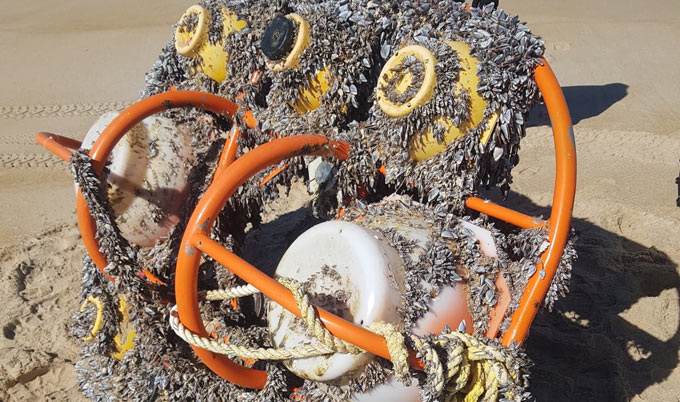Lost Lander
Lost lander returns
Published on: 18 December 2018
Missing ocean monitoring instrument found after five years at sea.
After going missing on Christmas Day five years ago, deep ocean measuring equipment belonging to the UK’s National Oceanography Centre (NOC) has been found on a beach in Tasmania - 14,000 km away from where it was last seen.
Deployed in 2011 as part of an expedition led by Dr Miguel Morales Maqueda, then a research officer at NOC and now a senior lecturer in oceanography at Newcastle University, UK, the deep-sea lander was dropped in the northern Drake Passage, a narrow section of the ocean between South America and Antarctica.

Presumed lost
Gathering information on the Antarctic Circumpolar Current, the largest ocean current in the world, the instrument was due to spend two years collecting data at a depth of 1100 metres, before being recovered on Christmas Day in 2013 by a research expedition on the Royal Research Ship (RRS) James Clark Ross.
However it did not return to the surface as planned for reasons that are not clear, possibly due to something getting tangled up with the release mechanism.
After being presumed lost, the deep ocean instrument frame has now been discovered washed up on a beach on the western tip of Tasmania. It was eventually identified as the missing lander by its serial numbers on two of the sensors.
“It’s amazing that it’s turned up after all this time,” said Dr Maqueda, who led the Antarctic Circumpolar Current research project for 10 years.
“Deep sea exploration is a risky business and there’s always a chance the equipment will be lost or stop working, so to find this now – and with some of the data still intact – is really exciting.
“Depending on when the batteries ran out, it is even possible that we will be able to track the lander’s journey from just north of the Falklands to where it finally washed up.”
Recovering the data
The data sensors have now been taken to the Commonwealth Scientific and Industrial Research Organisation (CSIRO) where a team have managed to successfully recover some of the information.
It is hoped that a scientific analysis of the recovered data will soon provide further insights into this remarkable journey.
This deep ocean platform was developed by a small team of engineers at the NOC (Mr Peter Foden, Mr Geoffrey Hargreaves, Dr Stephen Mack and Mr Jeffrey Pugh) to measure sea level by means of precision pressure sensors, as well as monitoring salinity and temperature.
Professor Ed Hill, Executive Director of the NOC, said:
“Finding this instrument is like an early Christmas present. The Antarctic Circumpolar Current is key to understanding the dynamics of the global ocean, so these sustained observations are incredibly important. There is no better place to make these observations than the narrow Drake Passage, which is why this instrument was deployed there before it made its epic journey to Tasmania.”
The Antarctic Circumpolar Current is three times bigger than the Gulf Stream and connects all three major ocean basins, transporting heat and carbon between them. In addition, it circulates around the whole of Antarctica, keeping warm ocean waters away. This allows the Antarctic continent to maintain its huge ice sheet.
Dr Maqueda adds:
“The Newcastle and NOC scientists and engineers involved in this project are very grateful to the person who made the discovery of the stranded frame, a local who wishes to remain anonymous, and his brave team of volunteers that recovered the equipment from a very remote beach only accessible by all-terrain vehicles. The invaluable collaborations of the Australian CSRIO and IMOS (Integrated Marine Observing System) are also acknowledged.”
Although the research project that this instrument was originally deployed for has now finished, research and annual measurements along the Drake Passage are continuing.
Currently they are conducted as part of the Ocean Regulation of Climate by Heat and Carbon Sequestration and Transports (ORCHESTRA) long term science programme, led by the British Antarctic Survey and involving Dr Maqueda and his team.
Funded by the Natural Environmental Research Council (NERC), this programme aims to use measurements of the Antarctic Circumpolar Current, alongside computer simulations, to radically improve scientific understanding of the circulation of the Southern Ocean and its role in the global climate. This programme has a particular emphasis on the way the Southern Ocean absorbs and stores heat and carbon.



